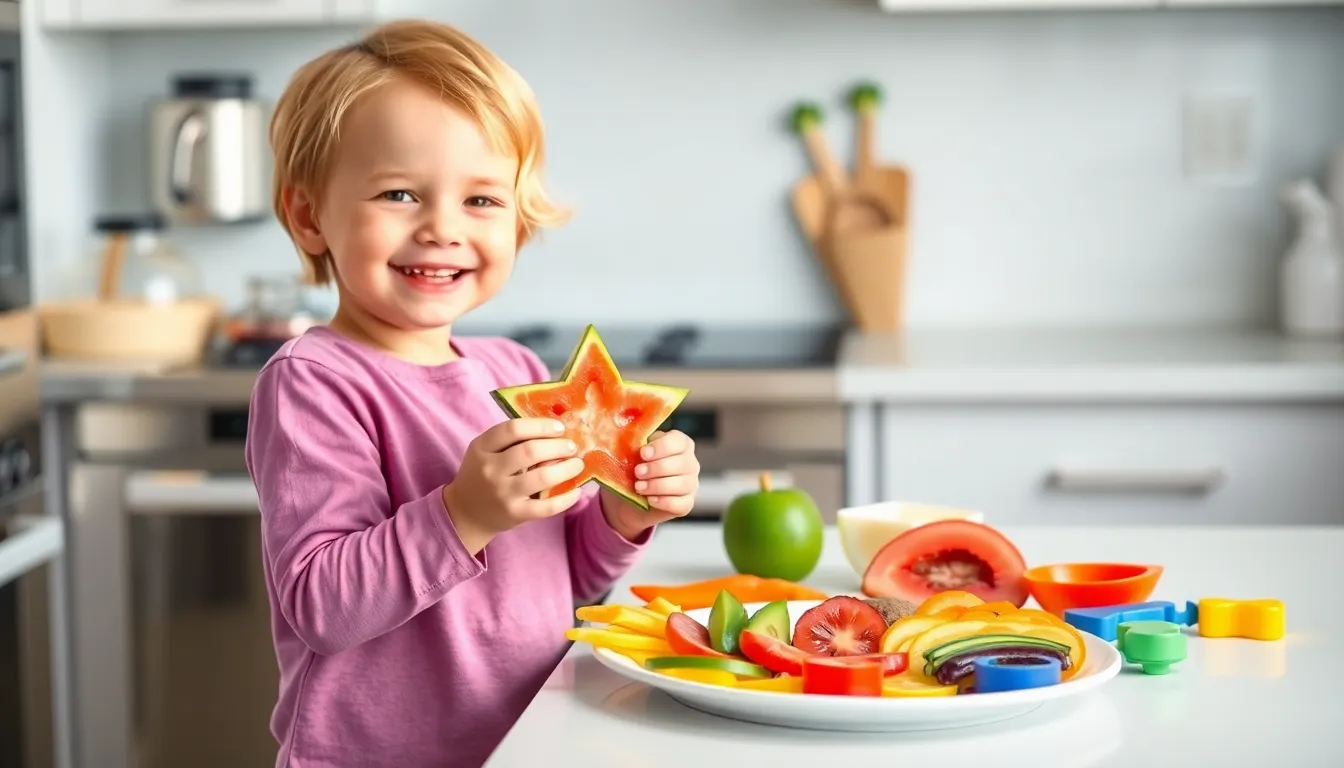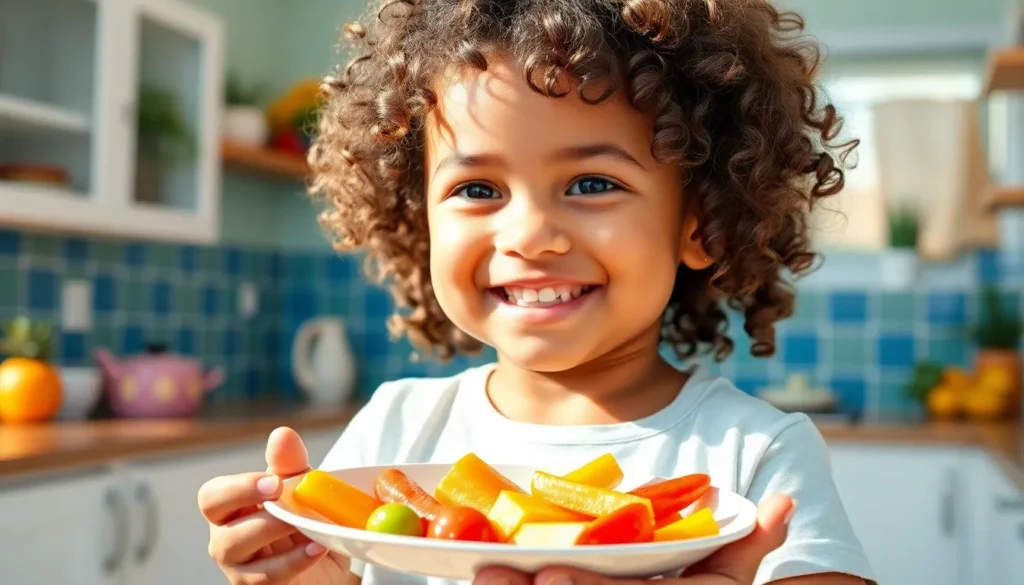Table of Contents
ToggleGetting kids excited about fruits and vegetables can feel like trying to convince a cat to take a bath. But fear not! With a little creativity and a splash of fun, parents can transform these colorful powerhouses into irresistible treats. Imagine a world where broccoli is a superhero and carrots are crunchy munchies that fuel epic adventures.
Importance Of Fruits And Vegetables For Kids
Fruits and vegetables play a crucial role in children’s health. These foods provide essential nutrients that support growth and development.
Nutritional Benefits
Fruits and vegetables deliver vitamins A, C, and K, which are vital for eye health, immunity, and wound healing. Magnesium and potassium are found abundantly in many vegetables, helping to maintain strong bones and regulate blood pressure. Fiber in fruits aids digestion and promotes a healthy gut. Consuming a variety of colorful fruits and vegetables ensures that children receive antioxidants, which protect cells from damage. Many studies show that a diet rich in these foods can lower the risk of childhood obesity and chronic diseases later in life.
Developing Healthy Habits
Introducing fruits and vegetables early helps shape children’s eating patterns. Regular exposure fosters a positive attitude towards healthier foods, encouraging children to choose them over sugary snacks. Making these foods part of family meals creates a shared experience around healthy eating. Offering fruits and vegetables in creative ways, like fun shapes or colorful presentations, can enhance children’s willingness to try them. Engaging children in selecting and preparing their fruits and vegetables also empowers them to take ownership of their health.
Fun Ways To Introduce Fruits And Vegetables

Playing with food can make fruits and vegetables fun for kids. Engaging visually makes these healthy options appealing.
Creative Presentations
Transform fruits and vegetables into fun shapes. Using cookie cutters, parents can create stars from watermelons or flowers from cucumbers. Arrange colorful fruit skewers for an eye-catching treat. Presenting food in a rainbow pattern on a plate adds excitement. Fun dips, like yogurt or hummus, enhance the experience. Smiley faces made from sliced fruits and vegetables spark joy. Encouraging kids to eat through creative presentations fosters interest in healthy eating.
Engaging Activities
Involving children in shopping creates interest. Take kids to the grocery store or farmers market, allowing them to choose fruits and vegetables. Gardening offers hands-on experiences; planting seeds teaches kids about growth. Cooking together cultivates skills and curiosity. Letting them wash, peel, and mix ingredients makes food preparation enjoyable. Experimenting with different recipes, like fruit smoothies or veggie wraps, introduces new flavors. Making these activities interactive helps kids connect with healthy foods.
Favorite Fruits And Vegetables For Kids
Fruits and vegetables captivate children’s taste buds when served creatively. Selecting appealing options ensures kids enjoy healthy choices.
Top Fruits
Berries like strawberries and blueberries provide antioxidants and natural sweetness, making them a favorite among kids. Bananas offer potassium and convenience, as they come in a portable package. Apples serve as a crunchy snack filled with fiber and can be paired with peanut butter for added fun. Grapes present a juicy treat, perfect for snacking with their easy-to-eat size. Oranges, bursting with vitamin C, create a refreshing experience while keeping hydration in focus.
Top Vegetables
Carrots stand out for their crunchy texture and beta-carotene content. Broccoli resembles tiny trees and is rich in vitamins, making it visually appealing. Bell peppers, colorful and sweet, introduce kids to a variety of flavors while offering vitamin A. Cucumbers provide hydration and crispness, often enjoyed with dips like hummus. Spinach packs iron and nutrients, which parents can incorporate into smoothies for a tasty twist.
Encouraging Kids To Eat More
Encouraging kids to eat more fruits and vegetables involves creativity and engagement. Nutrition plays a vital role in children’s overall health and development.
Tips For Parents
Present fruits and vegetables as fun options. Create colorful and appealing plates. Experiment with textures and flavors to captivate their attention. Use imaginative names for foods, calling broccoli “tree tops” or apples “crunchy treasures.” Offering choices empowers children while introducing variety. Snack preparation can include yogurt for dipping with fruit or providing hummus with veggie sticks. Sharing information about the nutrition behind each food can increase their interest. Acknowledge children’s preferences to ensure they enjoy healthy options.
Involvement In Meal Prep
Involving kids in meal prep sparks curiosity and excitement. Assign age-appropriate tasks during cooking, such as washing produce or mixing ingredients. Allow them to choose fruits and vegetables during grocery shopping. Gardening creates a direct link between kids and the food they eat, fostering appreciation. Encouraging them to try new recipes enhances their culinary skills. Additionally, presenting meals they helped prepare cultivates pride and enjoyment. Participation in these activities promotes healthier eating habits that can last a lifetime.
Encouraging kids to embrace fruits and vegetables doesn’t have to be a daunting task. By incorporating creativity and fun into mealtime, parents can spark their children’s interest in these nutritious foods. Engaging kids through playful presentations and interactive experiences fosters a positive relationship with healthy eating.
As children explore various flavors and textures, they’ll develop lasting habits that support their growth and well-being. With a focus on enjoyment and involvement, parents can transform mealtime into an exciting adventure that not only nourishes their bodies but also cultivates a lifelong appreciation for fruits and vegetables.







